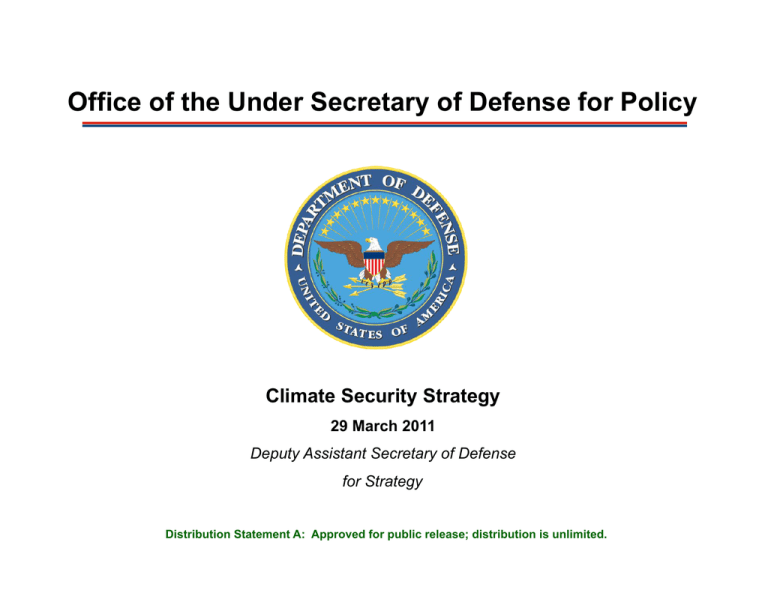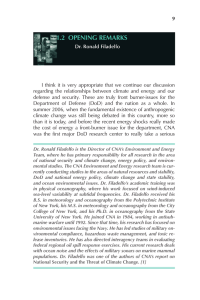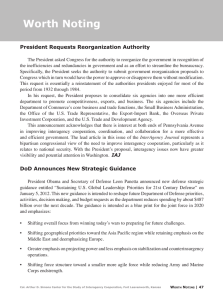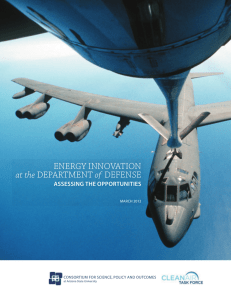Office of the Under Secretary of Defense for Policy
advertisement

Office of the Under Secretary of Defense for Policy Climate Security Strategy 29 March 2011 Deputy Assistant Secretary of Defense for Strategy Distribution Statement A: Approved for public release; distribution is unlimited. POLICY ! The 2010 Quadrennial Defense Review • Rebalances US military capabilities and reforms defense processes and institutions to: " Prevail in today’s wars " Prevent and deter conflict " Prepare to defeat adversaries and succeed in a wide range of contingencies " Preserve and enhance the All-Volunteer Force ! Contains a ground-breaking section on the national security implications of energy and climate change • 2 broad categories of climate change impacts on DoD " Roles & missions " Readiness 2 POLICY ! 2010 National Security Strategy (NSS) • “Our diplomacy and development capabilities must help prevent conflict, spur economic growth, strengthen weak and failing states, lift people out of poverty, combat climate change and epidemic disease, and strengthen institutions of democratic governance.” • “The danger from climate change is real, urgent, and severe. The change wrought by a warming planet will lead to new conflicts over refugees and resources ….” ! 2011 National Military Strategy (NMS) • “Preventing wars is as important as winning them, and far less costly.” • “In combination with U.S. diplomatic and development efforts, we will leverage our convening power to foster regional and international cooperation in addressing transnational security challenges.” 3 POLICY ! The Presidential Policy Directive on Global Development (PPD) • The directive recognizes that development is vital to U.S. national security and is a strategic, economic, and moral imperative for the United States. • Through the Global Climate Change Initiative (GCCI), the United States will integrate climate change considerations into its foreign assistance strategy to foster a low-carbon future and promote sustainable and resilient societies in coming decades. ! The 2010 Quadrennial Diplomacy and Development Review (QDDR) • The US State Department issued the first Quadrennial Diplomacy and Development Review (QDDR) in December of 2010. • Conflict prevention is a core mission for State and USAID. • Climate change is one of the century’s greatest challenges. 4 POLICY ! The “Prevent and Deter Conflict” element of the strategy seeks to shape the Future Security Environment (FSE) ! (from the QDR) Enduring trends and operational challenges will shape the FSE; these include: • Increasingly multidimensional conflicts (“hybrid” threats) • Threats to the global commons and expansion into space & cyber • Growing anti-access/area denial capabilities, including ballistic missile threats • Rise of new powers and growth of non-state actors • Lowered barriers for dangerous technologies, including WMD and ballistic missiles • Resource scarcity, climate change, disease, and demographics challenges 5 Notional Interagency Partnership on Climate Security Issues NASA, DOE National Labs, NSF, DOD, IC NOAA (Climate Service?) USGCRP (13 agencies) USDA, USGS, DOE Intelligence Community Energy Security Strategy Water Security Strategy Food Security Strategy • State/AID • USDA • USGS • DoD • USACE • EPA • Treasury Humanitarian Assistance/ Disaster Response PPD Global Devel. Prevention Response 6 POLICY ! It is no longer enough to simply recognize climate change as a national security issue. Now is the time to begin moving into the “planning and solutions phase.” ! Debate about whether or not climate change constitutes a stand-alone “threat” or whether climate change, by itself, causes conflict are less helpful than identifying prudent actions to begin taking, given our improving understanding of vulnerabilities and risks. • DoD should apply a risk management framework to climate change considerations. • Reducing the impacts of climate change will reduce the likelihood of conflict in vulnerable regions. 7 POLICY 8 POLICY BACKUP 9 POLICY ! First order effects • Temperature and sea level rise • Increased intensity of severe weather events • Ocean acidification • Increased water stresses (e.g., drought, flooding) ! Cascading effects • Competition for scarce resources such as water and arable land • Negative impacts on agricultural productivity leading to increased strain on global food markets • Challenges to governments due to resource allocation or possible mass migration • Evolving operating environment; climate change is a threat multiplier 10 POLICY ! Impacts on Installations • Over 30 domestic installations at increased risk due to sea level rise ! Impacts on Roles and Missions • Changing operational environment " Heat stress, water scarcity, increasingly accessible Arctic, etc. • Changing (expanding) requirements " Defense, Diplomacy, Development (3 “D’s”) to prevent conflict " Defense Support to Civil Authorities − Humanitarian Assistance/Disaster Relief 11 POLICY ! DoD is not the US Government “lead” on climate change or energy issues, but we can demonstrate leadership • Emissions reductions in support of national mitigation goals • Shared data and solutions to assist in adaptation efforts ! Interagency cooperation with other lead agencies such as State, USAID, EPA, and DOE • Support to initiatives such as National Climate Assessment and Adaptation Task Force • Collaboration with the private sector and nongovernmental organizations ! Build cooperative adaptation capacity through military-tomilitary engagement • DEIC Program and State Partnership Program 12






